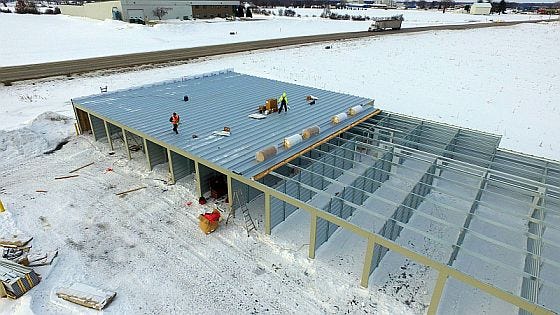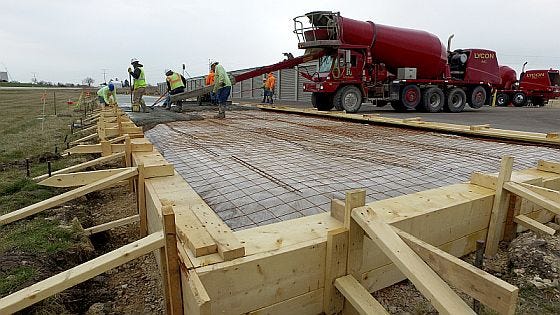Creating an accurate construction timeline is difficult, particularly for owners and developers who are new to self-storage. These tips on the sitework process can help you plan, set realistic expectations, avoid delays and keep your project on schedule.
August 3, 2022

Creating a realistic construction timeline tends to be difficult for new self-storage owners and developers. Most underestimate the time it takes to plan and build a facility, a problem that’s been magnified by ongoing supply-chain issues and labor shortages. To help you create a more accurate schedule, let’s examine the process from the perspective of an independent owner who’ll serve as their own general contractor.
Manage Expectations
When it’s time to create your construction timeline, try to begin with realistic expectations. Your goal is to open the facility as soon as possible, so you can start collecting rent and minimize the impact of interest expenses. But the fact is, your subcontractors will try to manage their schedules to eliminate downtime, which means they won’t always be available when you want them. You have to plan accordingly.
As you request bids for your project, ask contractors about their availability and the expected timeframe for their work, since their answers might impact your decision. To help guide your preconceptions, here’s the build sequence of a typical self-storage project:
Grading and stormwater systems (removing poor soil and bringing in fill/gravel base)
Utilities (temporary power and conduits between buildings)
Concrete foundations and bollards
Asphalt or concrete driveways
Metal buildings
Electrical/lighting
HVAC
Security cameras
Fence, gate and access control
Signage
Landscaping
Once you have your building permits in place, here are five important steps to follow in creating your self-storage construction timeline:
Check with your grading contractor to determine when site and conduit trenching will be ready for foundations.
Add time (sequentially) for your foundation and driveway contractors.
Build in extra time for weather and holidays, so you can determine your ideal building-delivery date.
Schedule your delivery date with your building supplier and, if contracted separately, your labor suppliers.
Give the metal erectors a head start, and then schedule the remaining trades to follow: electric, security, cameras, HVAC, fences/gates and landscaping.
Prepare for Delays
Most self-storage projects are susceptible to weather-related delays early in the sitework process. If the driveways are rivers of mud, nothing good will happen. Properly preparing the site with riprap (large rock base) and erosion-control measures can help mitigate this problem; still, build in some extra time. Also, keep in mind that your crew are people who have lives and families. If your project will be under construction during the July 4 holiday, hunting season or Christmas, expect that your contractors will take a few days off.

Crews install insulation and a standing-seam roof at Columbus Self-Storage
in Columbus, Wisconsin.
On a large-scale build, you may be able to have multiple trades working at the same time, such as concrete being poured at one end of the site while metal buildings are being assembled at the other. Though this sounds good on paper, it doesn’t always work out well. For example, during metal-building construction, the erectors will need to store and handle large bundles of material with a telescoping forklift, which requires plenty of room to work. But once the sitework is entirely done, the remaining subcontractors will have an easier time working on various portions of the project simultaneously. For example, once the roof is on, electrical installation can begin.
Focus on the Details
Some construction delays can be avoided through good planning and communication. They’re often the result of details that weren’t completely reasoned by the project owner or developer, or weren’t documented and communicated to contractors. On large projects, there’s normally pages of documentation on utility locations, lighting and electrical details, signs and more. Smaller projects might not have this level of detail prepared by the engineers, but it should at least be put to paper (and PDF) and shared with the project team.
Here's a great example of how planning prevents problems during the self-storage construction process: Conduits for power and data need to go into trenches before concrete is poured, and it might be tempting to simply ask your grading contractor to trench from point A to point B. But do they know where the bollards, gate foundation and fence posts will be? By planning the precise path in advance and defining exactly where your current and future conduits should be installed, you’ll avoid issues and give yourself a record for reference. The more detail you provide your contractors, the less likely they’ll need to pause work and contact you for information.

Workers pour a floating slab for a drive-up building at Columbus Self-Storage
in Columbus, Wisconsin.
Another way to keep the construction process running smoothly is to avoid making changes late in the game. Think through specifics like office design, keypad location and signage before breaking ground. When you’re in a rush to get things done, it’s often tempting to move ahead without fully defining these details, but late changes and upgrades will typically have more negative impact than you realize.
For example, let’s say you decide during construction to add a brick, wainscot wall to the end of your building for some additional curb appeal. A change like this is more involved than simply ordering some bricks and labor. For starters, the added weight will impact the foundation design, which will require some additional steel framing. Making decisions early and sticking to them will help prevent delays.
Doing Your Part
If you’re serving as your own general contractor, one of your jobs will be to ensure the timely arrival of materials to the self-storage job site. Under today’s conditions, with ongoing issues stemming from COVID-19 and supply-chain-induced chaos, this is no small feat. As soon as your permits and financing are in place, begin ordering materials.
The steel-building package is the obvious one, but don’t wait on other items that are prone to delay such as light fixtures, unit numbers, gates, security cameras and even your office PC. Materials procurement has been like a game of Whac-A-Mole for more than a year. For example, in February, a shortage of door springs was impacting some deliveries, causing the sectional-door industry to fall woefully behind. Even items like meter sockets (a small but essential item) have been in short supply. Don’t assume that any materials are in stock and available.
To help keep your project on schedule, visit the job site regularly. Speak with the foreman for the various trades to understand their work schedule, any obstacles they may face and upcoming needs. Don’t wait until they’re packing up the truck on the last day to give them a punch list. Also, keep in mind that any punch-list items may require replacement parts, which take time to order.
In your communication with vendors, be candid about pay schedules. Most developers pay their subcontractors from a draw. It can be smart to group your pay requests to reduce draw fees from your lender. Keep in mind, though, that the inspection and draw process can take a week or two. While you don’t want to throw away money on overly frequent draws, you also don’t want to earn a reputation as a slow-paying client.
Finally, if you choose to do some of the construction work yourself, know your limitations. I’ve earned some sweat equity on my own projects by installing video-camera systems, sheathing and faux-brick paneling. The benefit is I’ve saved many tens of thousands of dollars in labor. The downside is I’m one person and can’t work at the speed of a professional crew. In some situations, this can slow progress.
With the number of variables involved in any self-storage construction project, a few unavoidable delays are inevitable. To minimize their impact, use these timeline considerations in your planning process, and set realistic expectations to help you stay on schedule.
Steve Hajewski the marketing manager at Trachte Building Systems, which designs, manufactures and erects a full line of pre-engineered and customized steel self-storage systems, including single- and multi-story, portable storage, interior partition and corridor, and canopy boat/RV. He’s also a partner of three facilities in Wisconsin and a frequent contributor on Self-Storage Talk, the industry's largest online community. For more information, call 800.356.5824.
About the Author(s)
You May Also Like





